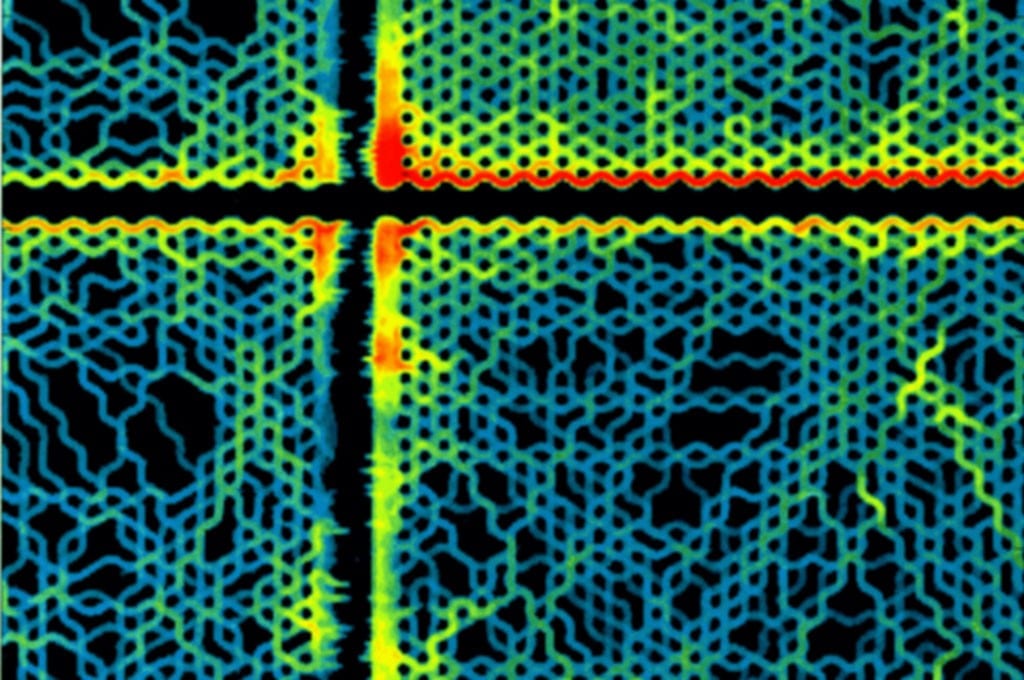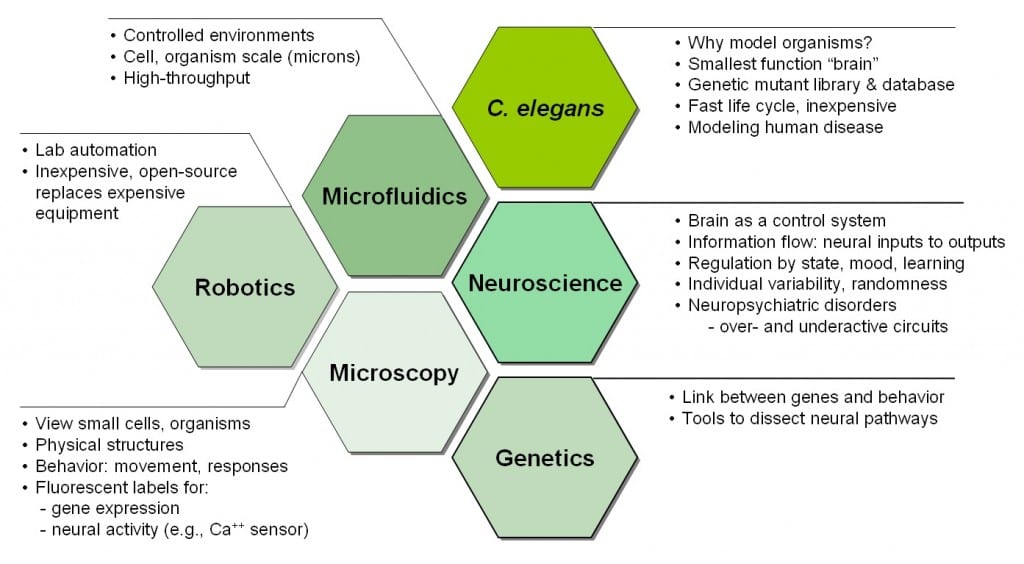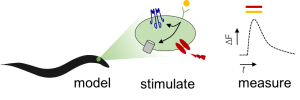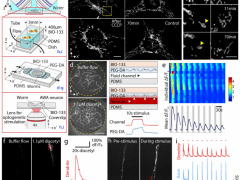
Research
Our lab develops microtechnology tools to observe in vivo neuronal and behavioral responses to precise stimulation. We study the molecular and genetic basis of neural excitability, how it directs information flow within neural circuits, and its role in neuropsychiatric disorders.
We are an interdisciplinary group, combining biomedical and traditional engineering with neuroscience, genetics and optics. 
Project Areas:
Our projects are focused on understanding how neural excitability is modulated by chemicals, genes, experience (such as learning), and states (such as sleep or starvation). Some current project realms include the following:
-
Functional screens for modulators of neural dynamics:
C. elegans can be used as a model for human disorders related to voltage-gated calcium channels, like epilepsy and autism. To introduce human mutations in the worm, we are using CRISPR-Cas9 and standard genetic techniques, like cloning, transgenics, crosses, PCR and sequencing. When appropriate, we characterize our models by monitoring and quantifying calcium activity (GCaMP) during microfluidic or optogenetic (Chrimson) stimulation. In parallel, we are combining these established techniques with our recently developed automated high-throughput screening methods to discover potential therapeutics that modulate calcium activity in C. elegans neurons. Altogether, we predict that our research will elucidate novel genetic etiology in human diseases and identify potential neuromodulators for secondary screens in vertebrates.

-
Light sheet microscopy for long-term multi-neuronal imaging with chemical and optogenetic stimulation:
Our lab has developed inverted selective plane illumination microscopy (diSPIM) methods to record high-resolution, isotropic, fluorescent 3-D volumetric images of multiple neurons for long periods of time (>12h). We use new protocols for the embedding and immobilization of small organisms (worm, fly, zebrafish, etc.) as well as cellular constructs and tissue sections (brain slices). We aim to study circuit computation in C. elegans when stimulated with natural sensory stimuli (e.g., chemicals) and with arbitrary optogenetic stimulation within compact and well-defined neural circuits. We use these methods to study neuronal response variability, decision-making, and to identify which neurons respond to novel stimuli.

-
Neural signaling changes across physiological and behavioral states:
C. elegans neural activity and behavior depend on individual animal state and exposure conditions. Our lab aims to understand how neural signaling in C. elegans varies depending on state differences including starvation, sleep and learning, and how these neural variations lead to behavioral output. We assess the learning capability of C. elegans under various stimulation conditions and genetic perturbations using an automated associative learning paradigm. For example, we study changes in associative learning during development, aging and in neuropsychiatric disorders such as Alzheimer’s disease. Additionally, we study how neural responses change during awake and quiescent (potentially, sleep) states.
Technologies
 Our current microfluidic technologies are able to record single neural responses from 20-40 animals at once, either moving or paralyzed, subjected temporal or spatial patterns of chemicals, gases, vibration, temperature, light, or combinations of these. These data have illustrated the reliability of some sensory neural responses and the variability of other interneuron responses give rise to probabilistic behaviors.
Our current microfluidic technologies are able to record single neural responses from 20-40 animals at once, either moving or paralyzed, subjected temporal or spatial patterns of chemicals, gases, vibration, temperature, light, or combinations of these. These data have illustrated the reliability of some sensory neural responses and the variability of other interneuron responses give rise to probabilistic behaviors.
We continually develop and refine:
- hardware systems to image behavior, deliver liquids from multiwell plates
- automation systems to coordinate microscopy, stimulation, and robotic systems
- software tools to coordinate multivariate data, track behavior, and track neural activity
Funding
We are currently funded by the Burroughs Wellcome Fund, the National Science Foundation, the National Institutes of Health, WPI, and UMASS Medical School.
Lab News
GRIE – Congratulations Hamilton White!
Congratulations Hamilton White for placing 1st in the Graduate Research Innovation Exchange (GRIE) poster competition for Life Sciences and Bioengineering! Hamilton’s presentation, “Impact of Traumatic Brain Injury on Sensory Neural Function, Behavior, and Neural Structure in C. elegans”, was chosen as a finalist from an initial pool of over 120 submissions in February. As a […]
Dan’s sleep paper is accepted in Journal of Neuroscience
Congratulations, Dan and coauthors! His paper “Sleep analysis in adult C. elegans reveals state-dependent alteration of neural and behavioral responses” is accepted at Journal of Neuroscience and is out in Early Release! https://doi.org/10.1523/JNEUROSCI.1701-20.2020 In this paper, Dan asked a basic question regarding how the nervous system changes its sensory responses during sleep. Sleep increases the […]
New preprint on a refractive-index-matched polymer for better light sheet imaging

Our collaborative effort with Hari Shroff at NIH and AcuityNano to characterize a new embedding polymer for live and fixed samples with much better image quality is out, here: https://www.biorxiv.org/content/10.1101/2020.10.04.324996v1 Getting great 3D imaging of live samples in a light sheet system requires refractive-index-matched materials, typically close to water (n = 1.333), but many embedding […]
Congrats, Hamilton on advancement to candidacy!
Hamilton White unconditionally passed his qualifier and advanced to PhD candidacy last Friday! Congrats!
Congratulations Dr. Daniel Lawler!
This morning Daniel Lawler presented and defended his PhD thesis “Development of Automated Analysis Methods for Identifying Behavioral and Neural Plasticity in Sleep and Learning in C.Elegans“. Dan’s dissertation aimed to develop high throughput behavioral assays for adult sleep using a closed-loop assessment system; which demonstrated microfluidic devices for associative learning and neural plasticity experiments.
Dan’s sleep preprint is out!
Congratulations Dan and co-authors on submitting the sleep paper! Adult C. elegans spontaneously sleep in microfluidic devices (depends on fluid flow, oxygen, hunger, and sensory stimulation), and we asked how neural responses change in sleep and awake states. Read more here: http://biorxiv.org/cgi/content/short/791764v1
Congratulations, Dr. Kyra Burnett!
Our newest PhD graduate successfully defended her thesis, “High-throughput and High-resolution Functional Imaging Methods to Identify Mechanisms of Variable Neural Excitability in C. elegans“. Congratulations to Dr. Kyra Burnett! In this dissertation, Kyra explored neural responses to a repeated stimulus whose neural response could change minute-to-minute, or remain consistent, identifying the neurons detecting novel stimuli, […]
Ross wins Sigma Xi doctoral dissertation award
Ross wins the 2019 Sigma Xi Outstanding Doctoral Dissertation Award for his PhD dissertation in 2018. This award, established in 1983, is presented for outstanding research by students at the doctoral and master’s levels and is sponsored jointly by the Society of the Sigma Xi and the Committee on Graduate Studies and Research. Congrats, Ross!
“Rapid and gentle hydrogel encapsulation” selected for First Anniversary Collection
“Rapid and gentle hydrogel encapsulation of living organisms enables long-term microscopy over multiple hours”, published in June 2018, has been selected for the Nature Communications Biology first year anniversary collection .




